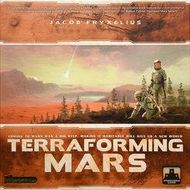

Humans have inadvertently warmed Earth by 1☌ as a by-product of industrialisation. So how do you warm a planet? Ironically, we already know one way. This makes Mars extremely cold, with an average temperature of -63☌ (-81☏). What's more, without a magnetic field, the thin atmosphere continually leaks out into space. Mars is further from the Sun, receiving 40% less light and heat than Earth. The first major challenge of terraforming Mars is to raise the temperature. "Who can doubt that if the first steps are taken, that the developments required to complete the job will not follow, for what is ultimately at stake is an infinite universe of habitable worlds." - Zubrin and McKay, Technological Requirements for Terraforming MarsĬan we terraform Mars into an Earth-like planet? And yet, some star-gazing scientists are conceptualising ways we could terraform Mars on the basis that we must start somewhere. In reality, such a challenge is immense-many orders of magnitude greater than restoring our own runaway climate change. It describes how we might modify the atmosphere, ecology, and surface topography of other planets to make them habitable to humans. In the 1940s, the science fiction author, Jack Williamson, gave us the term terraforming (literally Earth-shaping). While Earth and Mars share a solid surface, a similar day length, and a decent proximity to the Sun, there are unforgiveable differences relating to mass, atmosphere, and climate.

And this is where the biggest challenges lie-because in several critical ways, Mars is very different from Earth. The solution is to adapt Mars to our bodies instead. Even if it were possible for humans to biologically adapt to live on Mars, it would take us vast evolutionary timeframes to do so. Life on Earth evolved over billions of years under specific environmental conditions including temperature, pressure, and gravity. But how likely is it that we'll see cities on Mars in our lifetime? Is it even possible to terraform and colonise other planets with the science we have today? Terraforming Mars It's no secret that Elon Musk wants to colonise Mars as a backup home for humanity. The 100-year timeframe may be alarmist-but then again, things are really hotting up for humanity. With these catastrophic threats hanging over us, our security as a species falls to colonising other planets and moons. His fears included pandemics, climate change, nuclear war, artificial intelligence, or asteroid impacts wiping civilisation off the face of Earth. Planet is anywhere from 45 to 78 lunar distances from the red dwarf, distances presumably being measured from center to center, rather than surface to surface.Stephen Hawking once said that humans must colonise other planets within 100 years or face extinction. I do get stable solutions though, if the moon is very small-about the size of Dione-or rather, about the MASS of Dione, and orbiting at a distance of about 26000 to 45000 AU. Can't seem to get any respectably sized moon to orbit, though-Hill-sphere too small-the red dwarf primary yanks the moon away from Kesh, and the moon ends up in its own orbit. Atmospheric pressure is a little higher at 1.06.

Magnetic field on, and mass is somewhere about 70 to 90% of earth's. Generally, I am able to get a "probability of life" of somewhere between 0.4 and 0.6, and that's not half bad, considering that we're talking about a remarkably arid world orbiting an M0.5 red dwarf primary that shares its orbit with an F8-type star that is in the process of evolving into a red giant! I am also using a modified "Mars" to model the desert world of Kesh from "Kesh: The Sands of Destiny". All very good points worth further research.


 0 kommentar(er)
0 kommentar(er)
